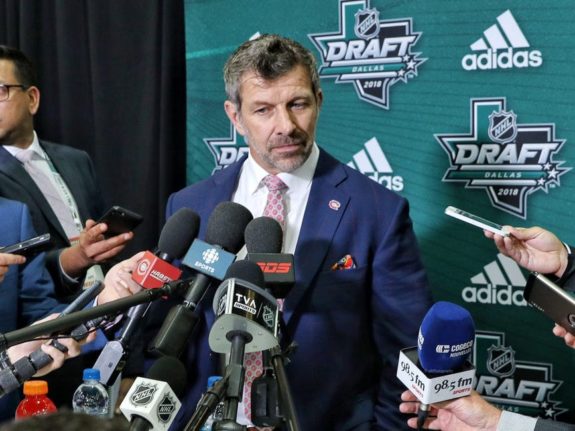Marc Bergevin’s retool is a gamble that hasn’t paid off. The Montreal Canadiens’ general manager sold the retool to his fanbase as a magic process that would have two simultaneous outcomes – developing young players, and winning.
It’s like the shopping channel selling the thing that can peel carrots and mash potatoes at the same time for $12.99. And just like the shopping channel, Bergevin warned of possible side effects, including not making the playoffs – possible frequent headaches, nausea and deja vu.
With hindsight on my side, I’m here to tell you that retools don’t work in today’s NHL, at least not for most teams. And here’s why…
NHL Parity Drives Up Value of Points in the Standings
Increasing parity between players and teams makes earning points increasingly difficult. Every game and every goal is critical. The outcomes of games are increasingly luck-driven because the skill is so high among all players and teams that a coach must push his team to scrape and claw for an advantage every play and every shift. This is even more important for so-called bubble teams like the Canadiens.
Coasting for a game or two is a thing of the past for most teams. Having a team that can compete every night is the job of the general manager. Declaration of a rebuild or a retool tells us that the priority to compete for points every game is secondary to developing players in the NHL; players that may not be adequately suited for competing at the level necessary.

The accompanying part of a retool is the reduced willingness to equip or fill the needs of the roster by trading assets. The theory being that trading assets, such as draft picks, would jeopardize the future of the team. So a retool also means no trading draft picks or young players for help. This effectively makes a retool a high-risk endeavour; a house of cards.
Cost-Benefit of Developing Players in the NHL
What is the cost-benefit of developing players in the NHL as opposed to the minors? Well, we’ve seen the cost this season with the Canadiens. If the players are not quite ready, the team loses games. The tweet below shows that several Canadiens’ forwards this season are having a net negative impact on the team’s performance.
In fact, three young Canadiens players – defenseman Cale Fleury along with forwards Jesperi Kotkaniemi and Ryan Poehling – are having low or negative impacts this season along with Nate Thompson, although, it should be noted that Thompson has more challenging deployment, including a high percentage of defensive zone starts.
But the potential benefit is tantalizing. Dressing a rookie has the potential for significant impact, as players like Jesperi Kotkiniemi have limitless ceilings compared to the alternative of a replacement-level player.
With a season all but lost, we can assess the benefits of the retool. They are, in no particular order, keeping assets (not paying draft picks or young players for appropriate help) and positive development of some players, particularly Nick Suzuki, in the NHL. The cost is also clear; losses that will likely lead to missing the playoffs and a cascading list of unfortunate things such as a losing atmosphere and all that comes with it, including missing out on exposing young players to playoff hockey and compounding the issues with attracting unrestricted free agents to play in Montreal.
Where would the Canadiens be today if they chose to sign or trade for a veteran player like Jordie Benn to play in the place of Cale Fleury? Fleury is an excellent prospect and has acquitted nicely in the NHL, but he is also the most isolated of Canadiens’ defensemen. A more defensively responsible defenseman, like Benn, would allow Claude Julien to deploy his defensemen more creatively; more aggressively, such as getting Shea Weber more offensive zone starts and advantageous matchups. Would this simple move add a few more goals? A few more wins?
Of course, the Canadiens have several defensemen, including Brett Kulak and Christian Folin, who were likely pegged to provide this kind of option. It didn’t work out, and Bergevin was reluctant to pay appropriate price to address this roster issue.
Act Like a Contender
Unless a team is in a full rebuild, there’s no reason for a general manager to leave holes in his roster, whether that’s at the start of the year or as holes appear. If your goal is to be a competitive team, then this message should first come from the general manager by respecting the critical requirement to be equipped to compete every game. In other words, act like a contender.
I’m not advocating trading first-round draft picks or blue-chip prospects, but some assets do have to be expended to keep a team competitive. For bubble teams, like the Canadiens, the concept of decisive and timely intervention is even more important to ensure the team can compete for every point possible.
In recent days Bergevin has made moves, sending Kotkaniemi and Fleury to the minors, but I wonder if these moves are too little too late. Are the valuable points in the standings already lost?